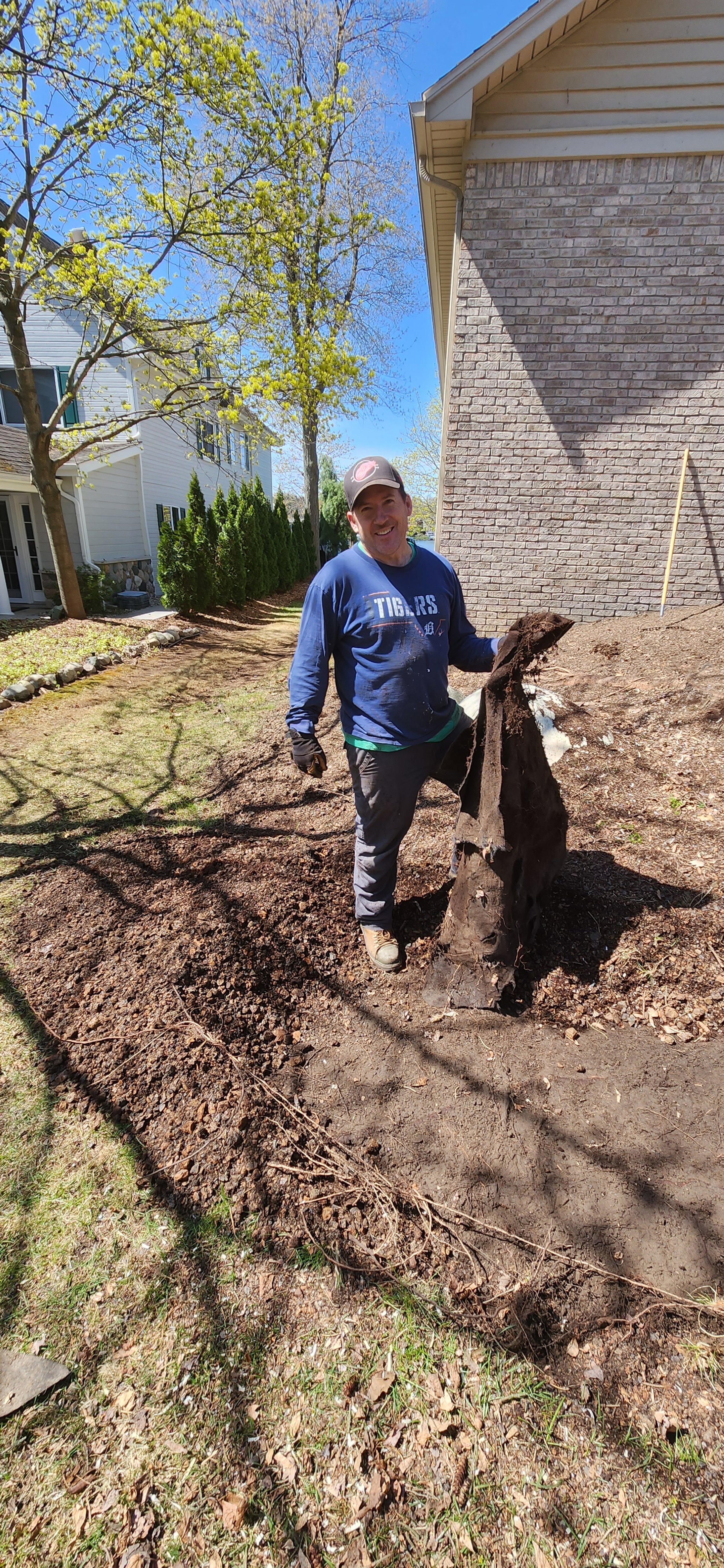Establishing Your Native Habitat
Do not let the perfect be the enemy of what is possible.
Native gardens sometimes occupy a mythical status, as if they alone can solve the wrongs of this planet. A garden planted in Detroit will not bring wolves back to SE Michigan. 500 Oak Trees planted along the roadway will not stop global warming nor will it solve the biodiversity crisis on earth. Your suburban native garden will not save the Monarchs. Your gardens will help in a very local way, so do not think I am telling you it is not worth it! I just want you to be realistic and dream at the same time. Ecology ranges from local to worldwide. Remember those Monarchs? To save them there needs to be viable habitat along their WHOLE flight path. In order to protect and create this habitat you have to deal with economic pressures, income inequality, development, resource management/exploitation, transportation, climate change… Anyone here want to sit down and resolve the issues in the Mexican economy? Humanity is destroying the Amazon Rain Forest in order to supply cheap meat! You get the picture. What you are doing is creating something small but beautiful in your tiny place on the planet. You are improving the local ecosystem and giving local populations of wildlife a bit of sanctuary, a place maybe just to rest before moving on to the next little native gem. You are getting yourself a better understanding of nature and your place with in it. You are removing yourself from the distractions of the digital world as you observe and interact with this place. You are showing neighbors what is possible beyond the sterile lawns and boring foundation plantings (maybe you will even convert some, but do not hold your breath). You are making a statement and thumbing your nose at conventionality. Yes, this is a bit of a rebellion. You will also experience sadness, anger and dejection as once you see nature as it should be you will never again be able to unsee the catastrophes, the blight and pollution human development has wrought.
Rose Milkweed
Put the plant where it belongs and FGS have a plan:
Plants have specific needs and requirements that if not met will result in a very poor showing indeed. Understand these requirements and pick plants appropriately. How much sun is required? What is the moisture level of the soil? How big does it get? How quickly does it spread? Common Milkweed is a beautiful plant that requires sun and dry to average soil moisture. It spreads rapidly. Put it in a wet shady spot and it will soon meet its maker. Put Swamp Milkweed in a wet sunny spot, and it will thrive. Know the areas that you wish to plant and pick plants that match the conditions. The best growing conditions are listed for each plant, shrub and tree available from Plants for Ecology. Diversity matters! Nature thrives with diversity. Include as many species as you can in your design. A greater the variety of plants will encourage a much greater variety of visitors and residents, and it builds resilience in the landscape. Use of plant plugs can be an effective and cost saving method to creating that needed diversity. Some situations do merit limiting the number of species in order to create a more formal design. Areas with a more conservative understanding of landscaping may need to be eased into this new understanding that native landscaping brings. What this boils down to is having a plan: 1. Understand the conditions of the area to be planted. 2. Know what you are planting and where before you begin. Do the same for the hardscape and other non-plant elements. Draw it out with proper measurements and needed instructions. 3. Remove all invasive/non-native species and even native species that are diseased, too entangled in the invasives to be saved or in locations that can harm structures. 4. Gather the needed tools, materials and hands. 5. Follow this plan but make adjustments when needed. If something is not working, change it up or figure out why it is not. Be thoughtful and strategic.
When designing a landscape, one can choose a very formal design to a very informal (restoration type planting) arrangement (and anywhere in between). All require work, but I do believe that very formal designs are more labor intensive. I tend to use a combination that puts me somewhere within the two book ends. Beyond understanding the growing conditions on the property, one needs to understand the setting. Is this rural or urban? What is the size of the property? What types of landscapes currently exist in the community (if you choose a more wild design in a very traditional neighborhood, expect some pushback and side-eyed stares)? Do you understand the municipal and/or association rules governing the landscape? Generally, on smaller properties in neighborhoods with homes close to one another, designs should lean more toward the formal. Formality to me involves things such as defined bed lines, the use of less rambunctious species for a cleaner look, pathways and other features that fall under “cues to care”. Make these cues well-defined so observers can readily see the design. Tend more toward species that are easier to control and maintain. It is very easy for any planting to evolve into chaos if the wrong plants are chosen. Backyards give us more opportunity to explore our more wild natures, but you still are likely to share fence lines in the back. You should act like a good neighbor. Maintain your landscape and do not hinder, create obstacles or create maintenance for those around you. I understand there is some irony in that statement, as these very neighbors are likely growing non-native plants that are invaded your landscape- hold them to the same same standard! There is no such thing as a maintenance free landscape. Maybe over time, the sensibilities of your location will change and allow you more latitude in how you approach you landscape, so this will allow you to cash in your good neighbor points. Bigger properties do give you more options and a wider range of wildness, but there will still be areas of the property that more formality will be helpful.
What is a plant matrix and what are layers? A matrix is simply a plant community, or a grouping of various compatible plants. I do not like the term matrix, as community is much better suited when discussing ecology and nature. When creating your design and picking your plants, it is import to know which plants grow well with others. A good design will put together plants that integrate well with each other and develop healthy checks and balances. So your plan will involve some matchmaking. Sometimes in order to create a healthy community, you may have to sacrifice a bit of your own desires to create community. Layers can be looked at as stories in a building. First floor are your groundcovers, and other low growing species. Second floor are those with a bit more height…trees tend to be the top floor when present. When done well you are setting yourself up for success.
With native landscaping comes the recognition that the garden is not solely for your own personal enjoyment. You are helping to create a shared space, a community. Yes, you are a part of this community and your needs should be met, but traditional landscaping is based on defeating nature in order to create an outdoor living room for humans. Any garden or landscape is by its inception an effort to control nature, but there are degrees. It should be obvious that enjoying nature does require letting go of some of our own sense of control.
Preparing the Beds
Violets
Bed preparation is essential, and will strongly influence the success of any planting. Clearly identify what needs to be removed. Concentrate on invasive species removal and create an appropriate timeline based on species present. Turf grass is easily addressed in one season whereas Phragmites or Knotweed will require an extended timeline. You will need to understand the each species and treat them appropriately. You will also find native species, and a determination will need to be made if they can be saved. Endanger, rare or high value/keystone species should be saved whenever possible. When native species are so intertwined with invasives, saving the natives may not be possible. You may find that saved plants have remnants of invasive species and by replanted this stock you have also replanted the invasives. There are strategies to avoid this like “barerooting” the native species or selective herbicide treatments. These are labor and time intensive, so use sound judgement. Areas cleared of invasive species will many times rebound nicely with a wide range of native regrowth. These are your pioneer or disturbed site species. Identify which of these fit the plan. Remember that not every plant is appropriate for a given site. This means removal of native species may be required. I recommend relocation if possible to a site better suit for the species in question. I recently had to remove an old Silver Maple as a result of internal rot. The tree was too close to homes and other structures. Leaving it would have been detrimental to the planting.
Preparation is the most labor intensive and requires specific knowledge of treatment options, so you need to decide if this is something you want to tackle or if hiring a landscape professional is the right move- The Maple tree that was removed was 80’ and needed to be handled by a professional tree service. If you do hire a landscaper make sure you are clear on your expectations and they communicate clearly with you to avoid misunderstandings.
Common Site Preparation Strategies
There are always positives and negatives to every method and it is up to you to decided what is best based on the needs of the site.
Smothering vegetation with cardboard/paper and mulch is a very popular and effective method when done in the right situations. I no longer us broken down cardboard boxes for this method because of the time required to collect it, the space needed to store it, gaps in the material and because many boxes are treated chemically and there is no way of knowing what type of chemical was used. I now use rolls of extra thick builders paper (Trimaco x-paper) which saves time and space and is untreated. It is also very easy to overlap seams to prevent vegetation from sneaking through. I use this method when planting on flat areas (Sloped areas can result in mulch piling at the base) over turf grass, annual weeds or other easily controlled weeds. This process is not effective in other situations. Since the the paper readily breaks down it is only effective when short term smothering is all that is required. This means there is not a long delay between prep and planting, but best results do require a waiting period in order for vegetation to die and for the mulch and paper to begin to breakdown. Typically, if the prep is done in the spring, planting can be done in the fall. If done in the fall, plant the following spring or even fall if there are delays- waiting a bit longer allows for more decomp and a more mature planting medium in the top layer. I usually calculate a 2” mulch layer over top the paper, but I will add more in situations where the soil has been really neglected and is very compacted. I highly recommend adding leaves on top, as the science is clear that leaves are great for building soil. I have also used straw in place of hardwood mulch. It can be easier to spread but it does contain some seed that will sprout (it is easy to removed these growths) and there is likely to be herbicide residue in the straw- I like to use bales that have sat around a bit and have aged some. Much is pretty easy to get and be delivered, but straw bales are not as easy to source for delivery. Soil is only really needed if existing topsoil needed removal and thus replacement, but it is always best to have plants acclimate to existing conditions without amendment. I will sometimes use topsoil to top off plantings of larger species of trees when existing soils are compacted or difficult manipulate, but even in these situations the native soil is still primary. The application of mulch and leaves adds organic material to the planting site, so soil requirements should be minimal. Be careful when sourcing soil, as it may contain seeds of invasive species. Try to only use high quality soils. One argument against mulching is that it blocks the movement of oxygen and moisture through the soil. Although a valid concern when mulch is overdone, long term this does not pose a major issue. Remember that mulch is only recommended at the preparation stage of the planting; it is not something that needs or should be done every season.
People have also found success with plastic sheeting (black) which is used to smother vegetation like cardboard. Plastic sheeting can be an option for more stubborn vegetation, when herbicides are not an option or where the slope is too steep to hold mulch. Typically the plastic sheeting is affixed to the ground with lawn staples, but I recommend not adding mulch on top since the plastic needs to be removed prior to planting. Weigh down the plastic with timbers or boulders is not a bad idea. The timing of plastic sheet smothering is similar to paper when dealing with turf grass, but when managing other more stubborn species, plastic tarps may need to be left in place for a year or more. An advantage of that is it does bake and destroy the seeds of some species close to the surface. It is easy to tell if the tarping has been effective. The ground underneath should be bare or contain only dead top growth. A drawback to plastic is that it can negatively affect soil health by limiting oxygen in the ground and by killing soil organisms. It does seem likely that affected soils do rebound quickly once the plastic tarps are removed. The tarps can be unsightly and do generate more plastic waste. Even if reused multiple times, they eventually end up as garbage. Once plastic tarps are removed, I do recommend adding a 1” layer of mulch prior to planting. Planting can proceed right after the mulch is spread. As mentioned in the other methods, leaves should be added to these new planting areas.
Mechanical removal and weeding can be effective in small plantings when dealing with turf grass, annual weeds, and non-hardy weeds. Weeding is effective if the whole root mass is removed, but it is very easy to leave roots in the ground which can result in re-growth and greater spread. Manual removal is more applicable when doing maintenance in already established plantings. When manually removing growth, I recommend a 1” layer of mulch after vegetation is cleared. Planting can proceed directly afterwards. I do not like using sod cutters. This removes organic material from the soil and requires the addition of soil to the planting area. It also creates the problem of what to do with the cut sod. It is a lot of work for minor reward.
Chemical herbicides should be used in situations for which mechanical means are ineffective. For example, Bishop’s Weed (Aegopodium podagraria) is an extremely stubborn plant that can regrow from any root materials left in the soil. Imagine how difficult it would be to remove all root materials mechanically! The last thing you want is to plant an area only to see the old invasives take over again. There are many invasive species that can only be effectively removed through the use of herbicides. Unfortunately, these species can still be very stubborn and require multiple applications. Patience is important and planting should only proceed once invasives have been effectively controlled. Do not use pre-emergent herbicides and only use according to the label. Do not over-apply, do not use on windy days, do not use on rainy days! Species respond to herbicide differently and each species should be understood and treated accordingly. Do your research. Planting can commence shortly after, but this does depend on herbicide used. When I apply Glyphosate, once I am sure the applications have been successful, I wait at least 1-2 weeks before planting. I also apply 1” layer of mulch just prior to planting. As mentioned in the other methods, leaves should be added to these new planting areas. It is pure insanity to clean your garden beds like it is your living room.
Do not till the soil. Tilling disturbs and activates seeds in the seedbank which is simply the layer of soil just beneath the surface that retains the seeds of those species that were there prior to your project. Many if not most will be non-native species whose regrowth will seriously hinder your new landscape. Also limit how much you need to dig for the same reason. The less you have to dig and disturb the soil, the better off you will be. Tilling also damages soil structure and can lead to soil compaction. This in turn leads to water run off and oxygen deficiency as neither cannot penetrate the soil.
Hardscape should go in at the same time as the preparation. This type of work can be very disruptive, so it only makes sense to do it prior to planting. It is also recommended that other needed work be done at this time-maybe you need a new roof or painting needs to be done for example. Yopu do not want folks tromping through a newly planted meadow!
Never use landscape fabric. This product was developed for the landscape industry with the promise that your living room gardens will never need to be weeded again. This product is expensive and a pain to install. Weeds do take root in the fabric leaving you with two options only- consistent use of herbicide or ripping out the fabric and starting over. Both options are terrible and are contrary to a healthy landscape. Just don’t do it. There is a picture below showing a landscape that require the removal of this fabric. It was a difficult job!
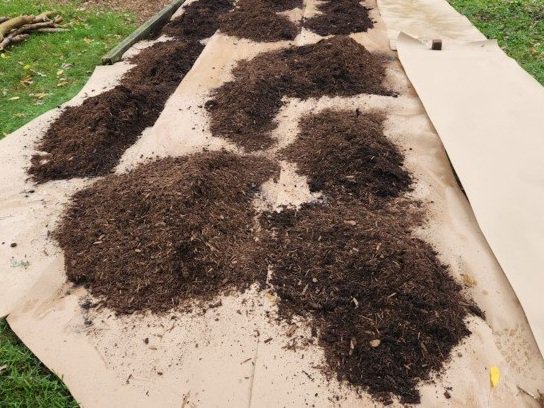
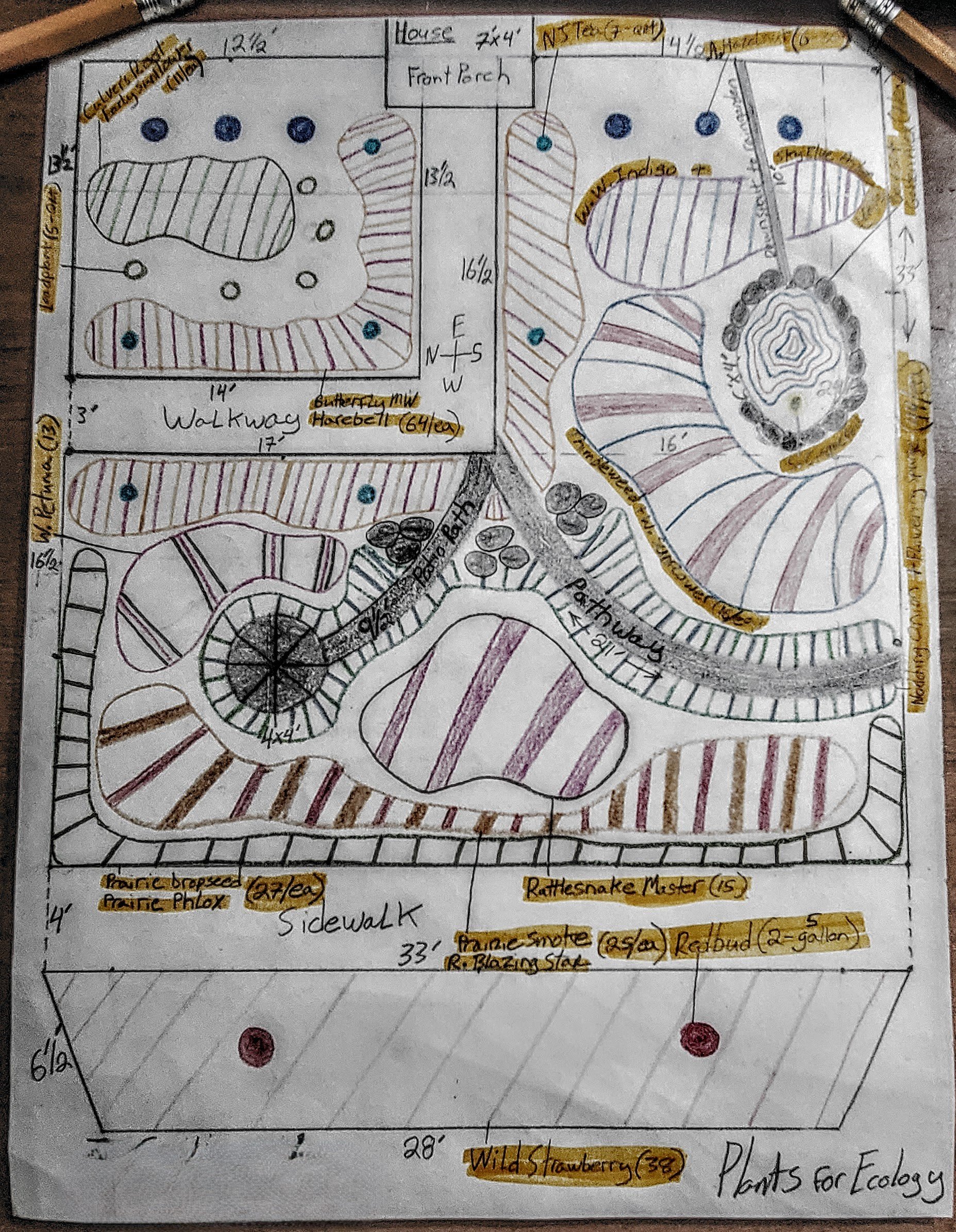
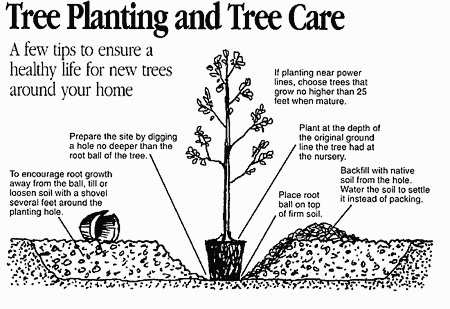
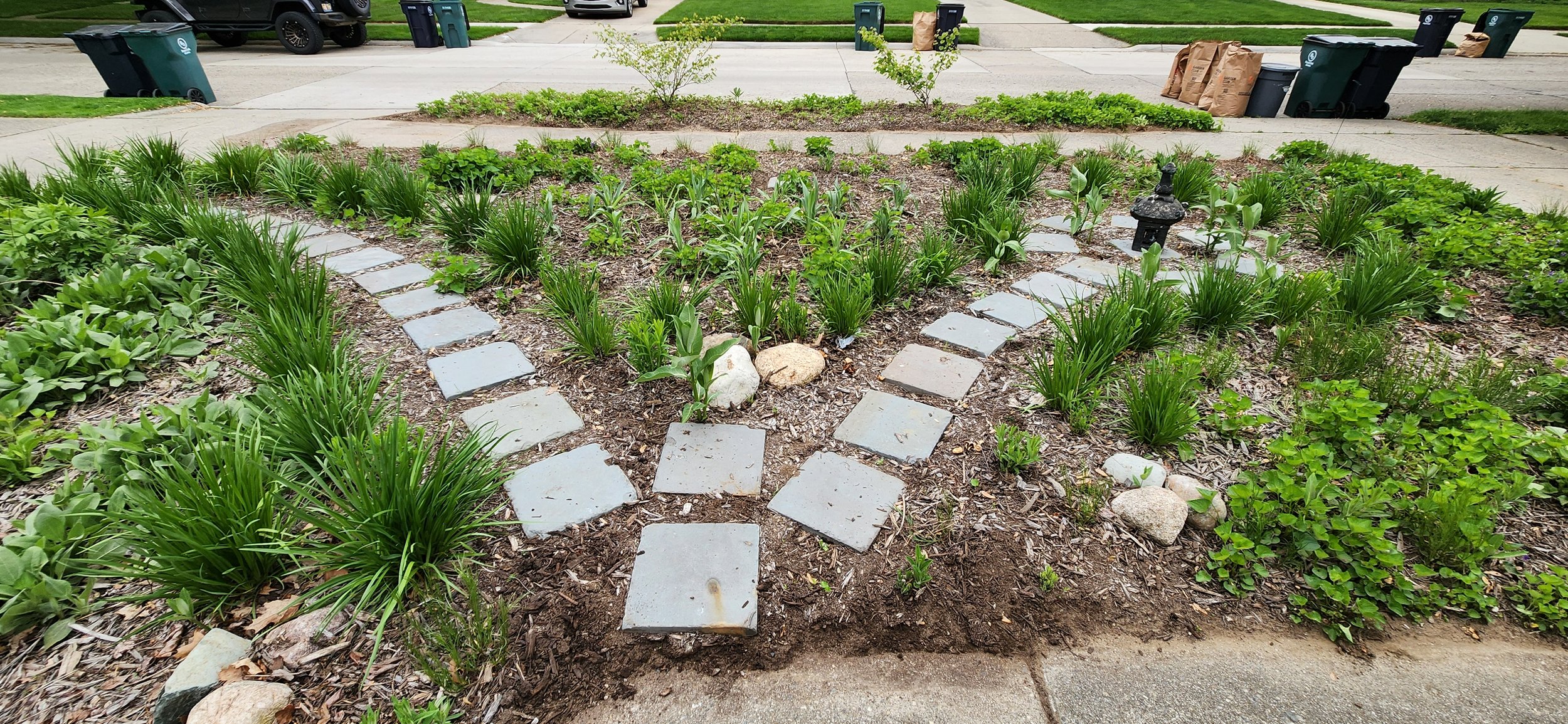
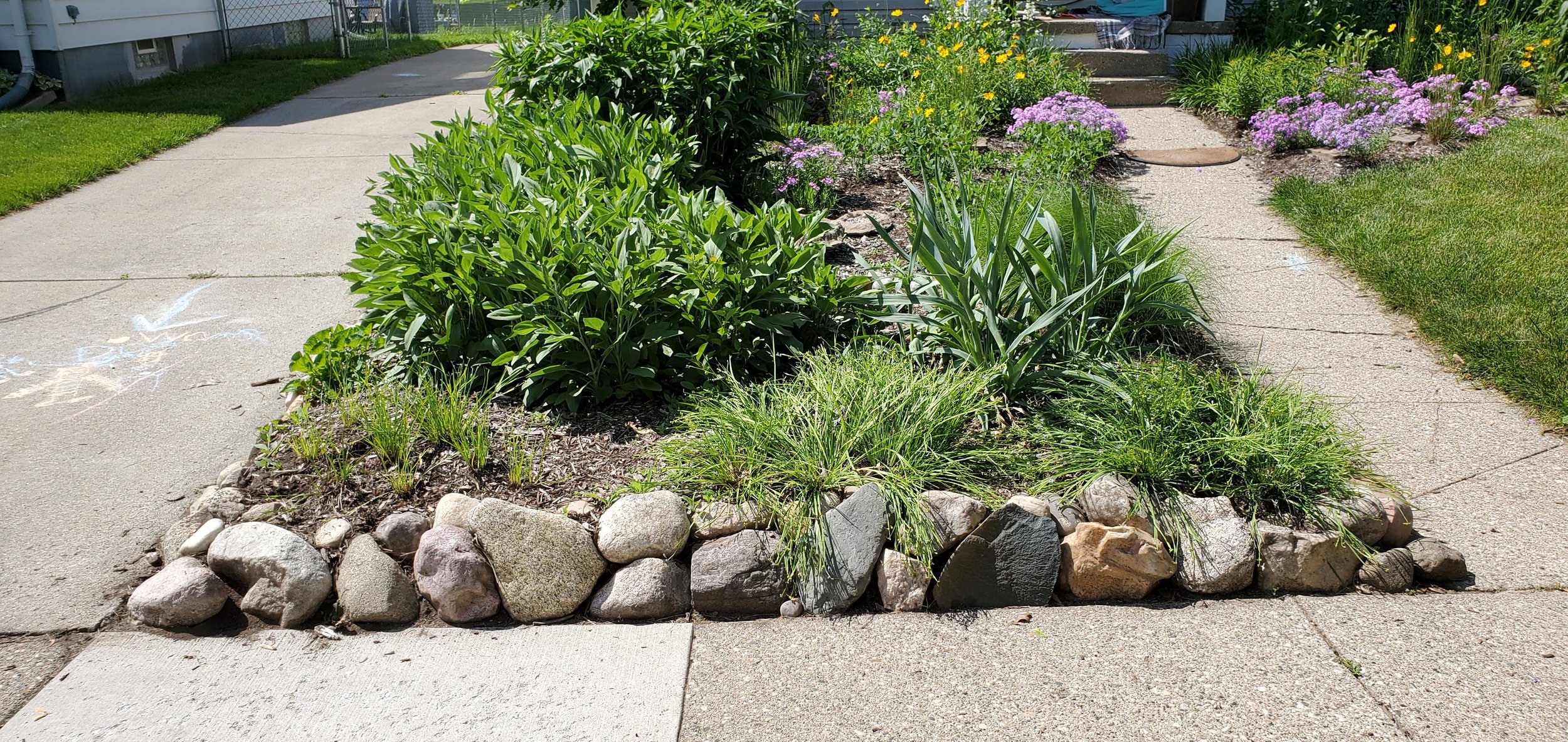
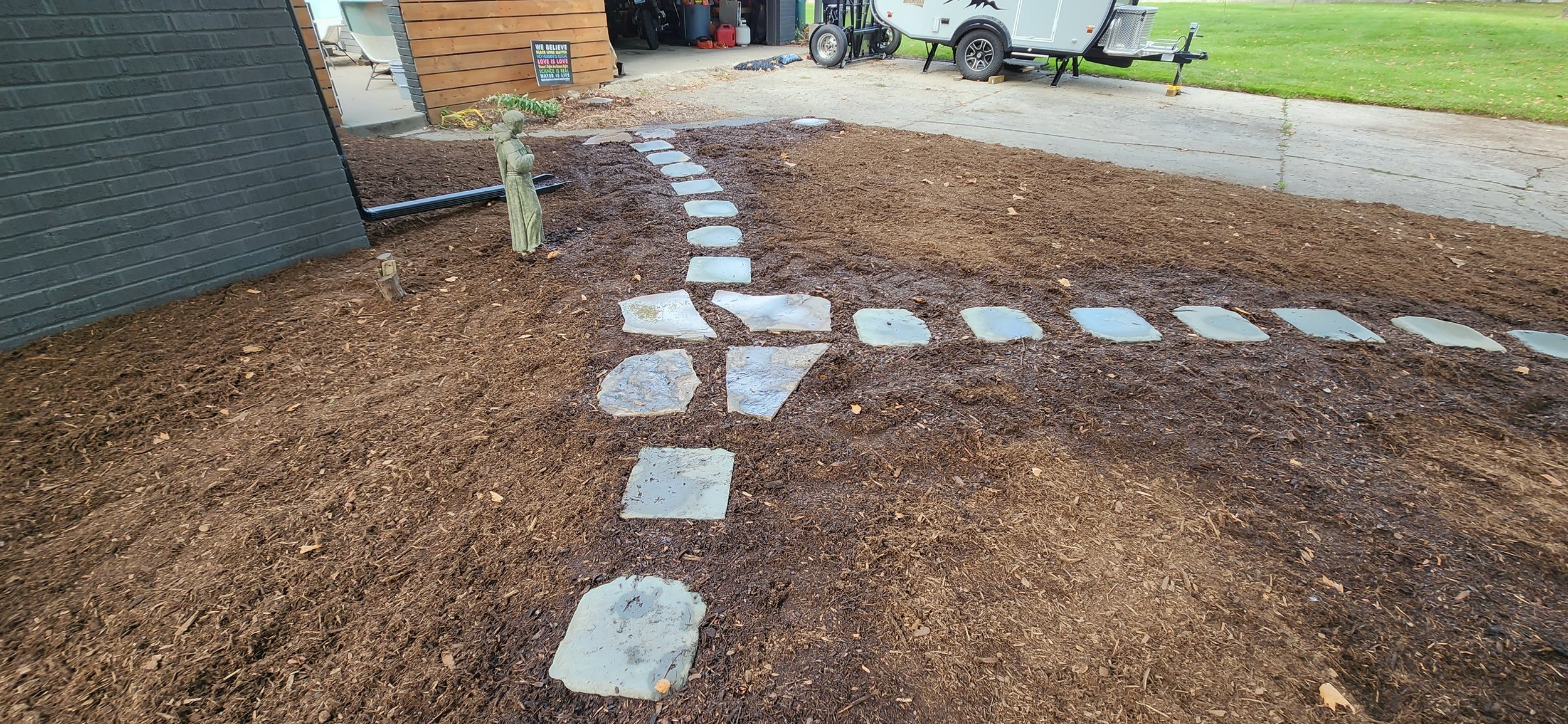
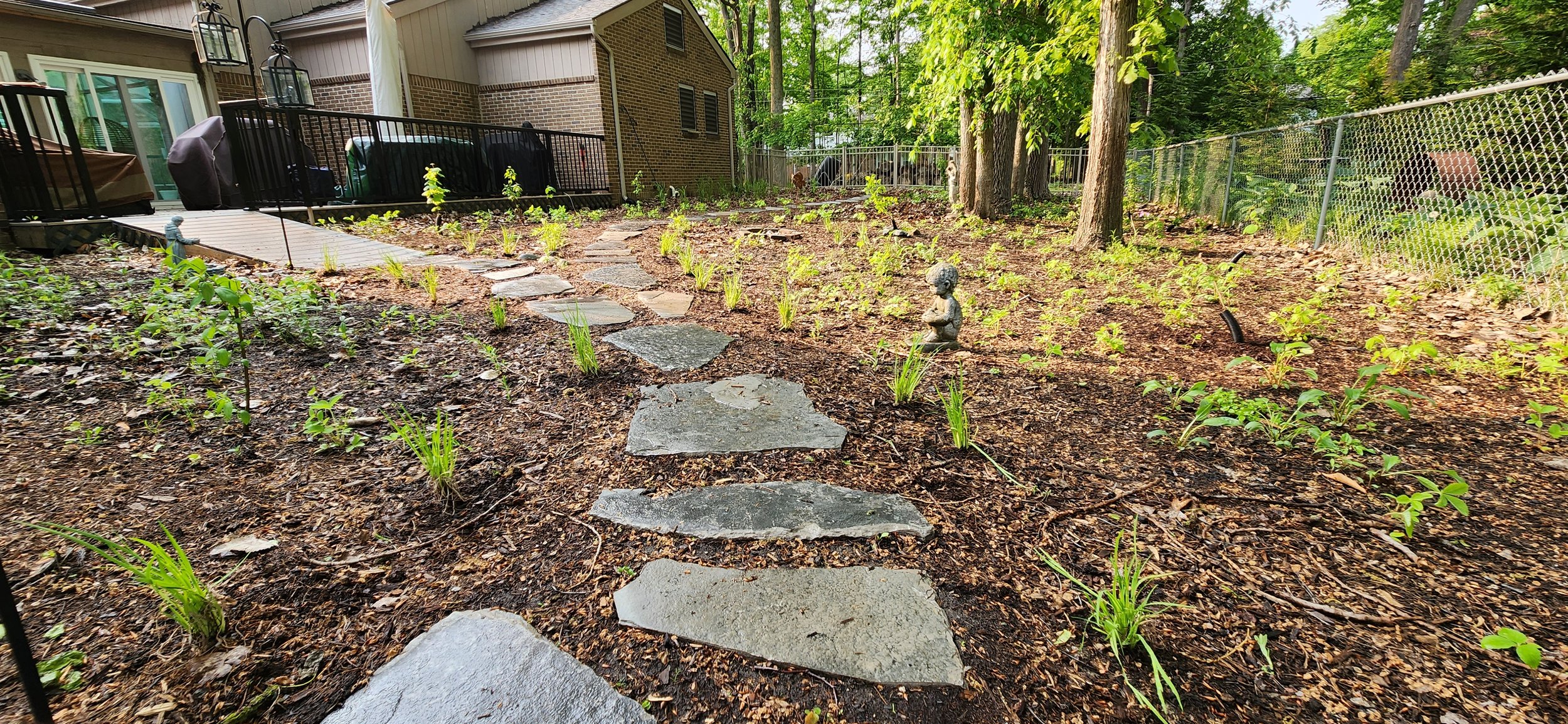
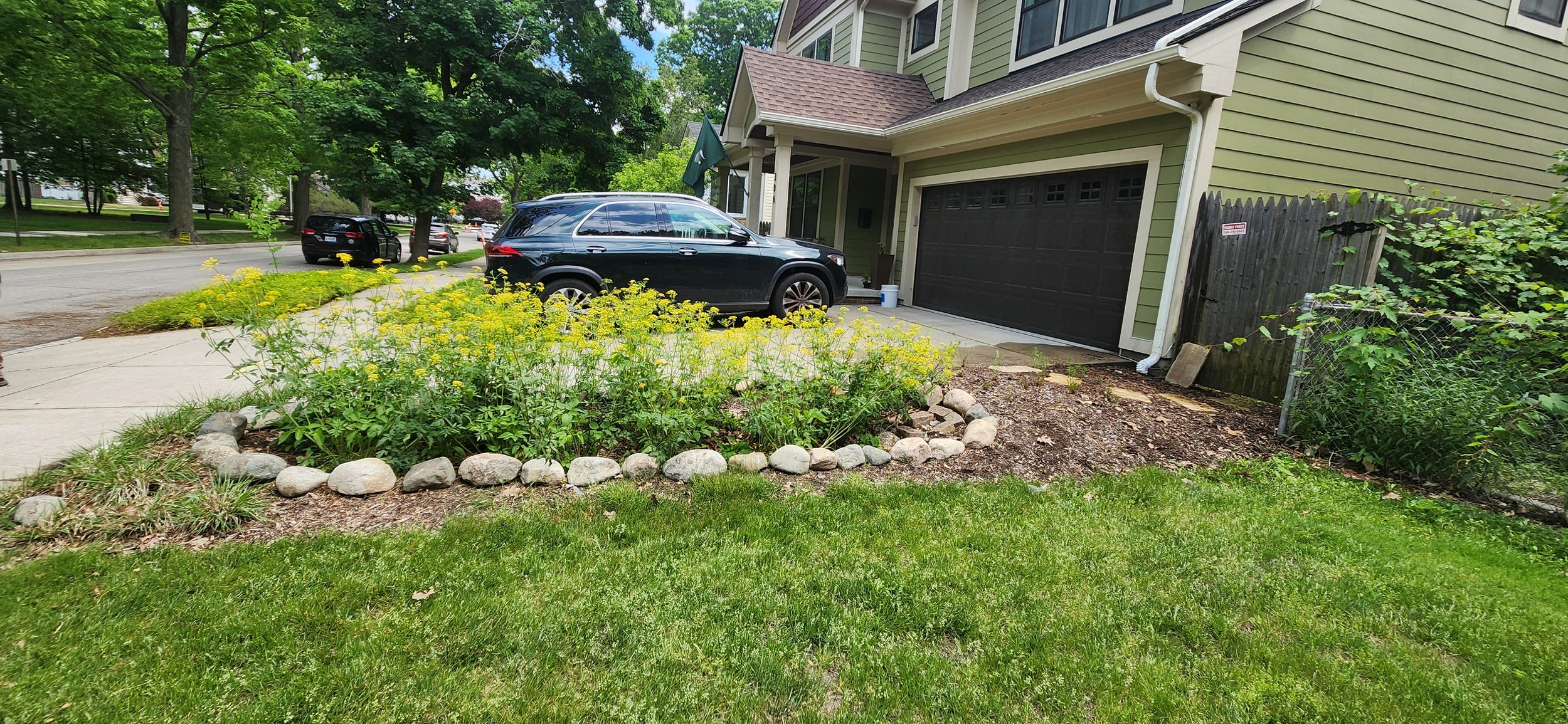
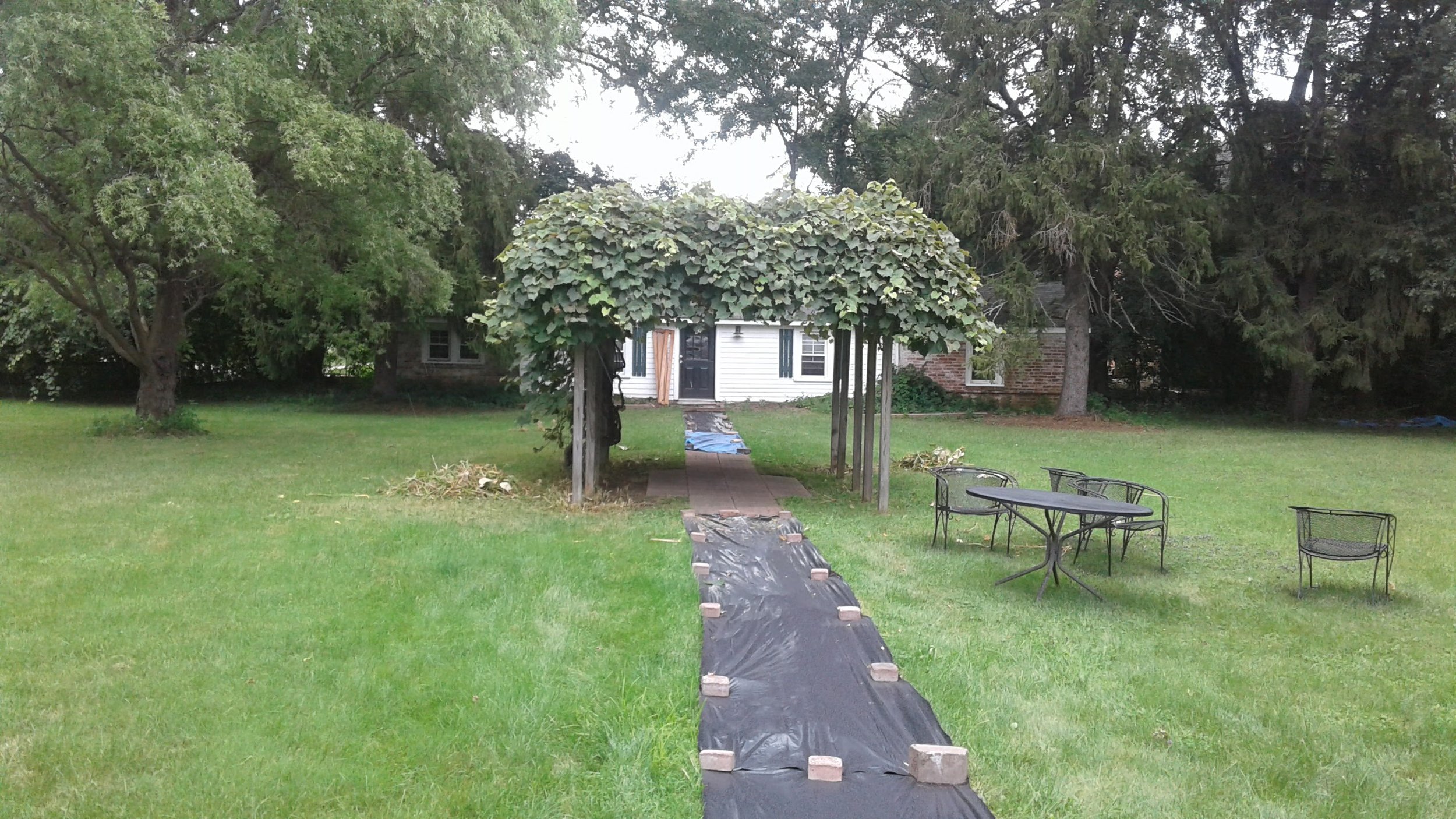
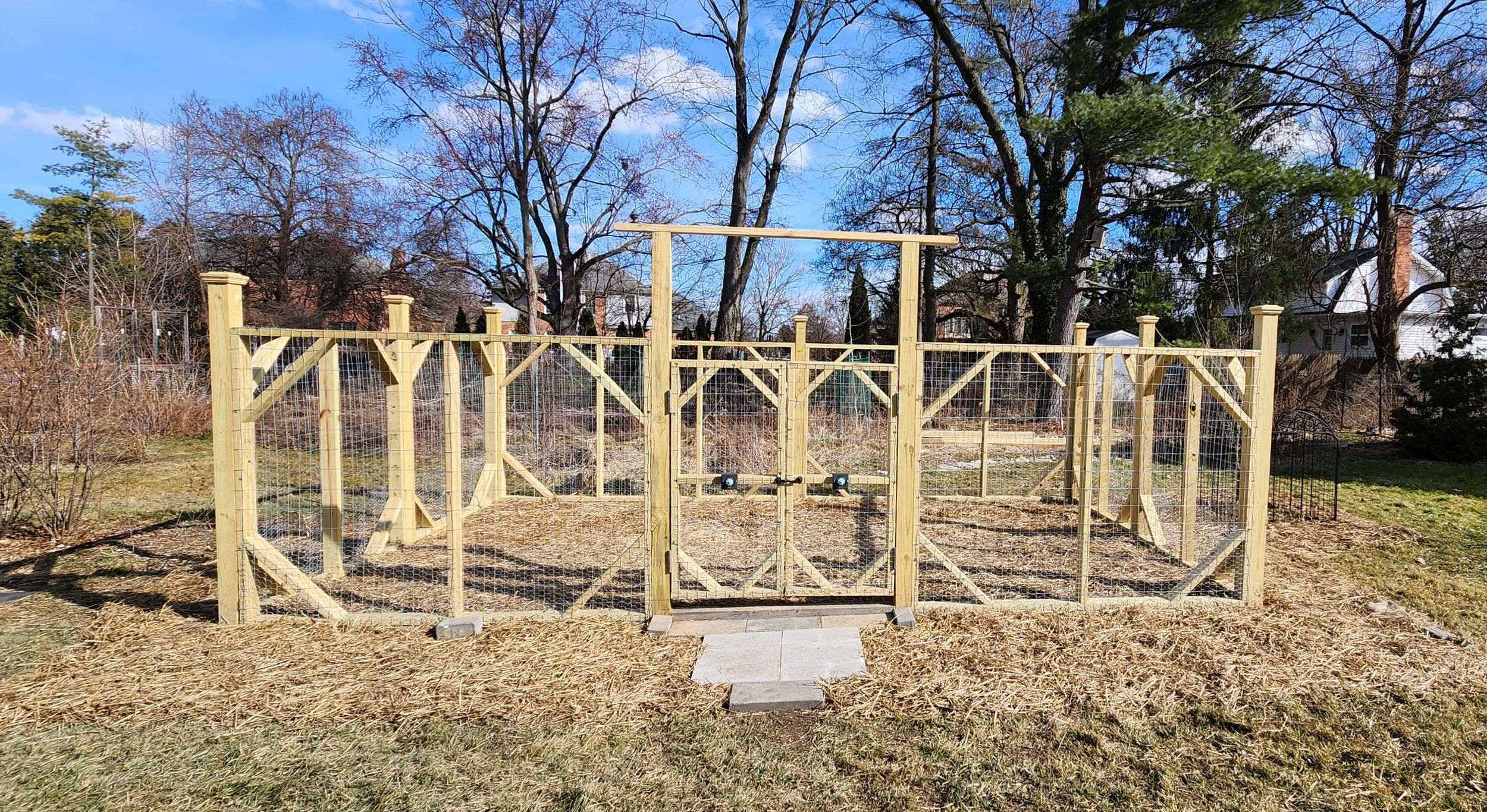
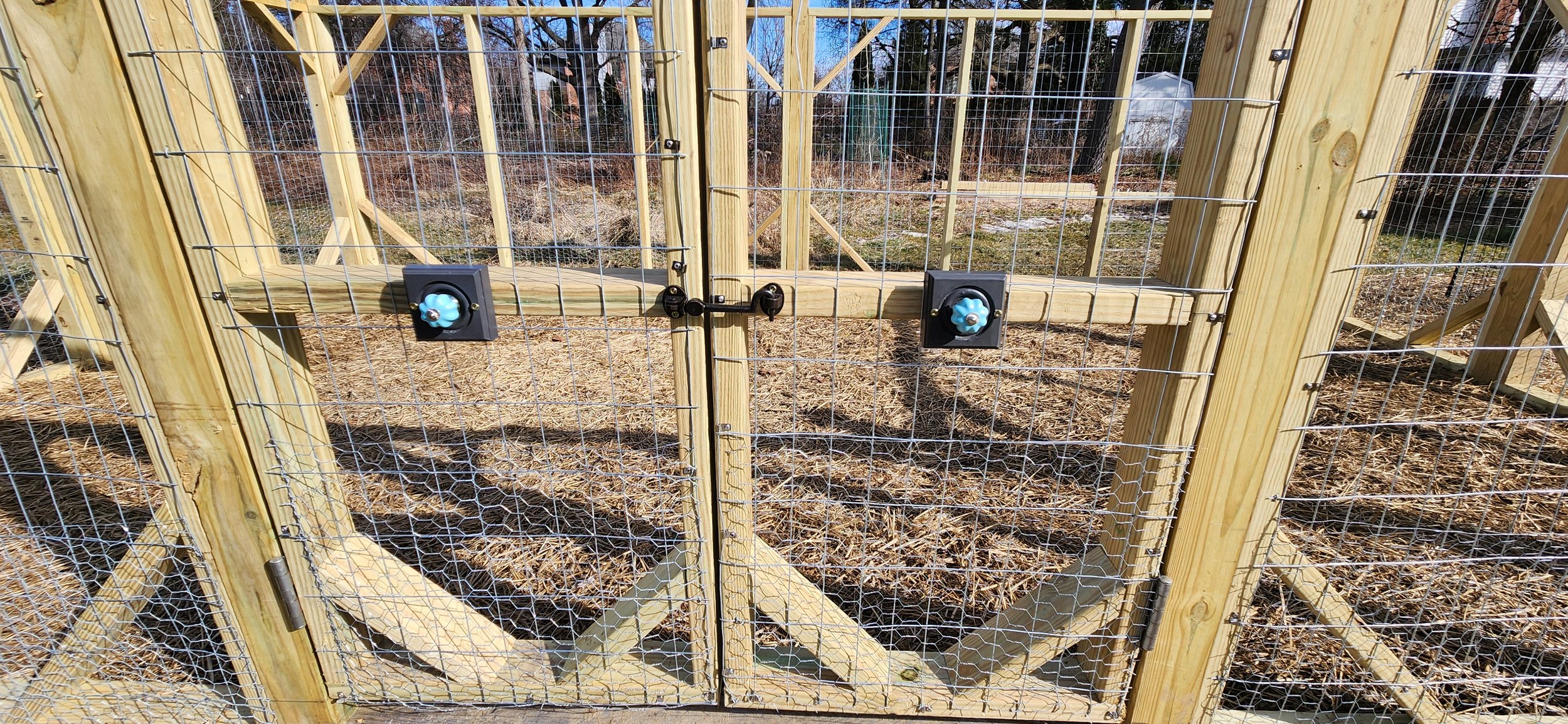
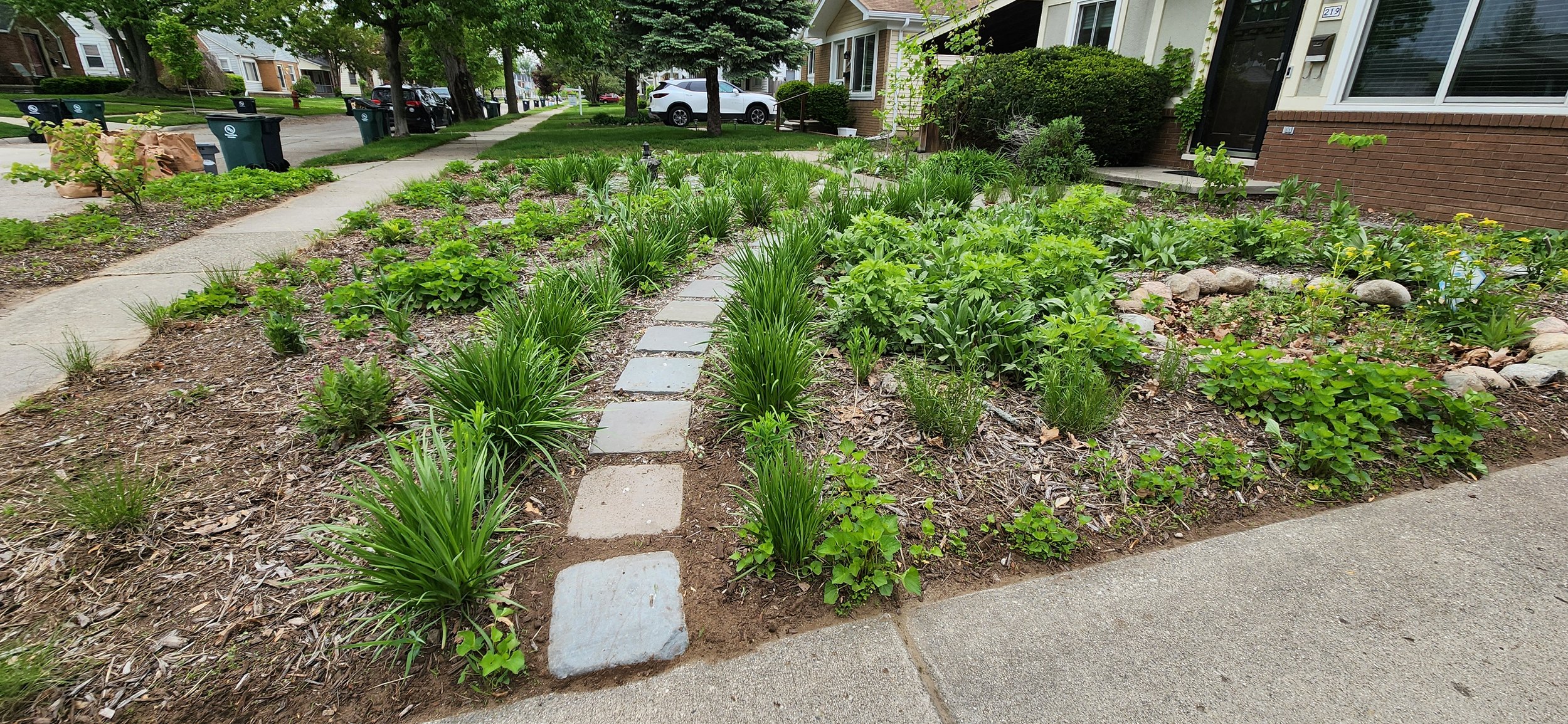
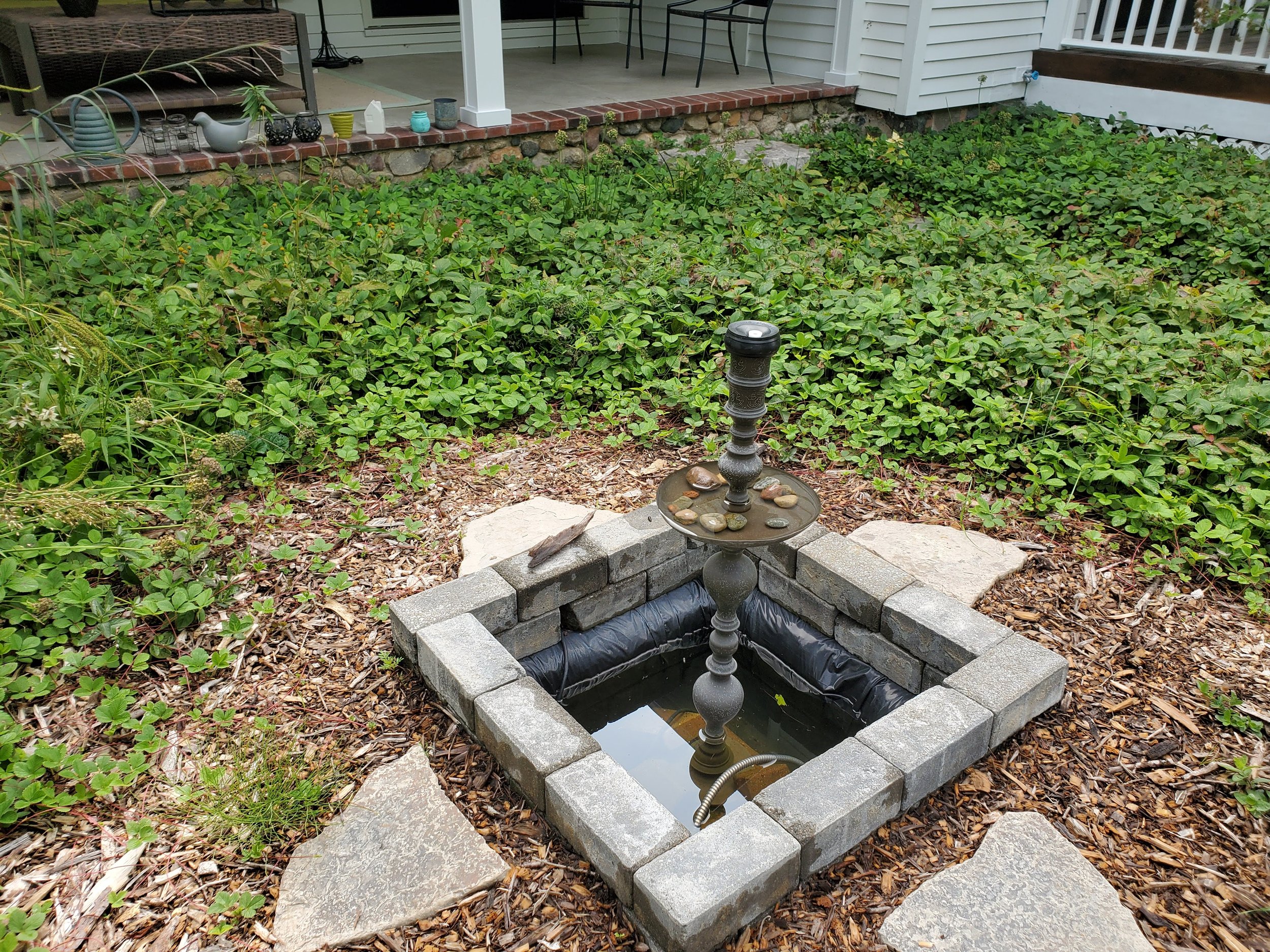

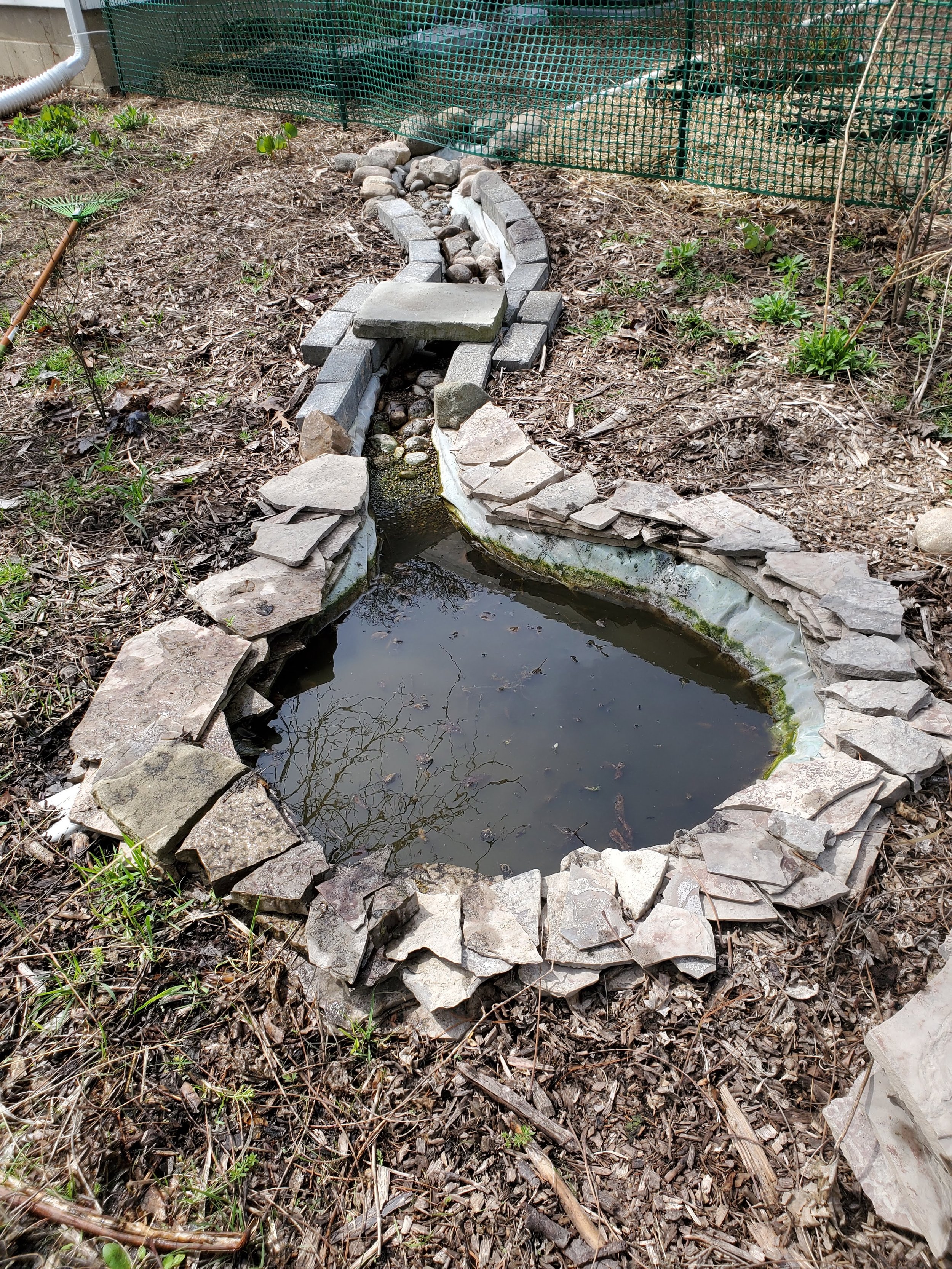
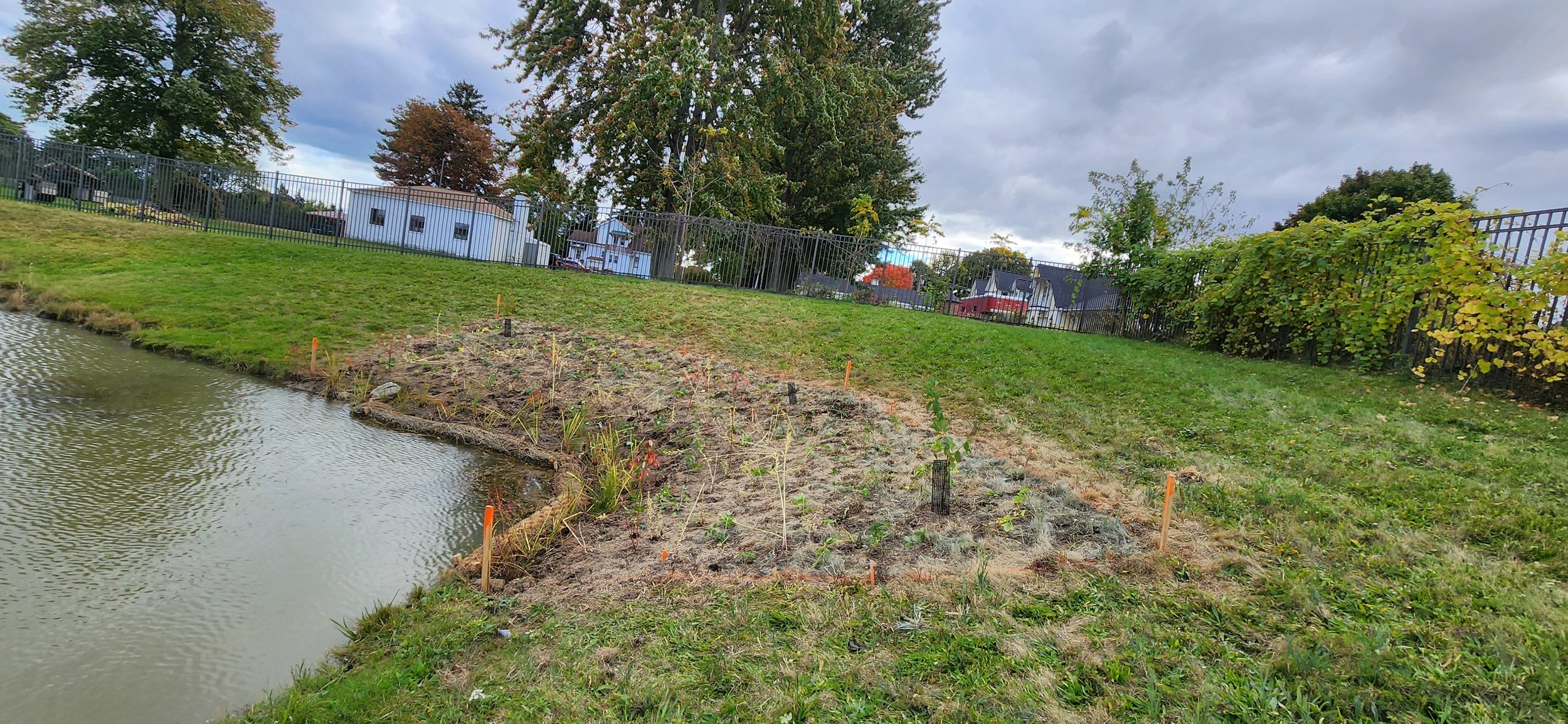
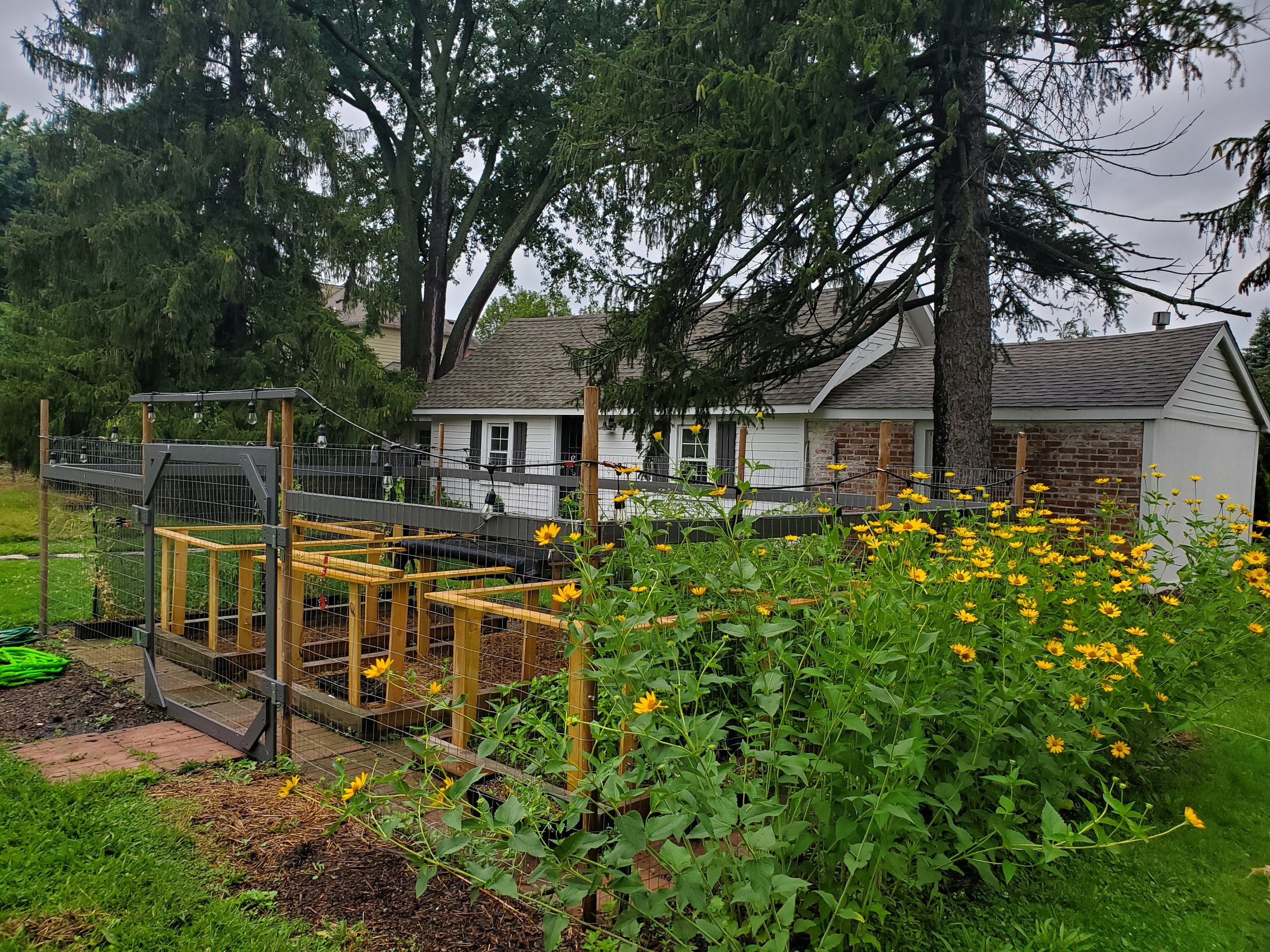
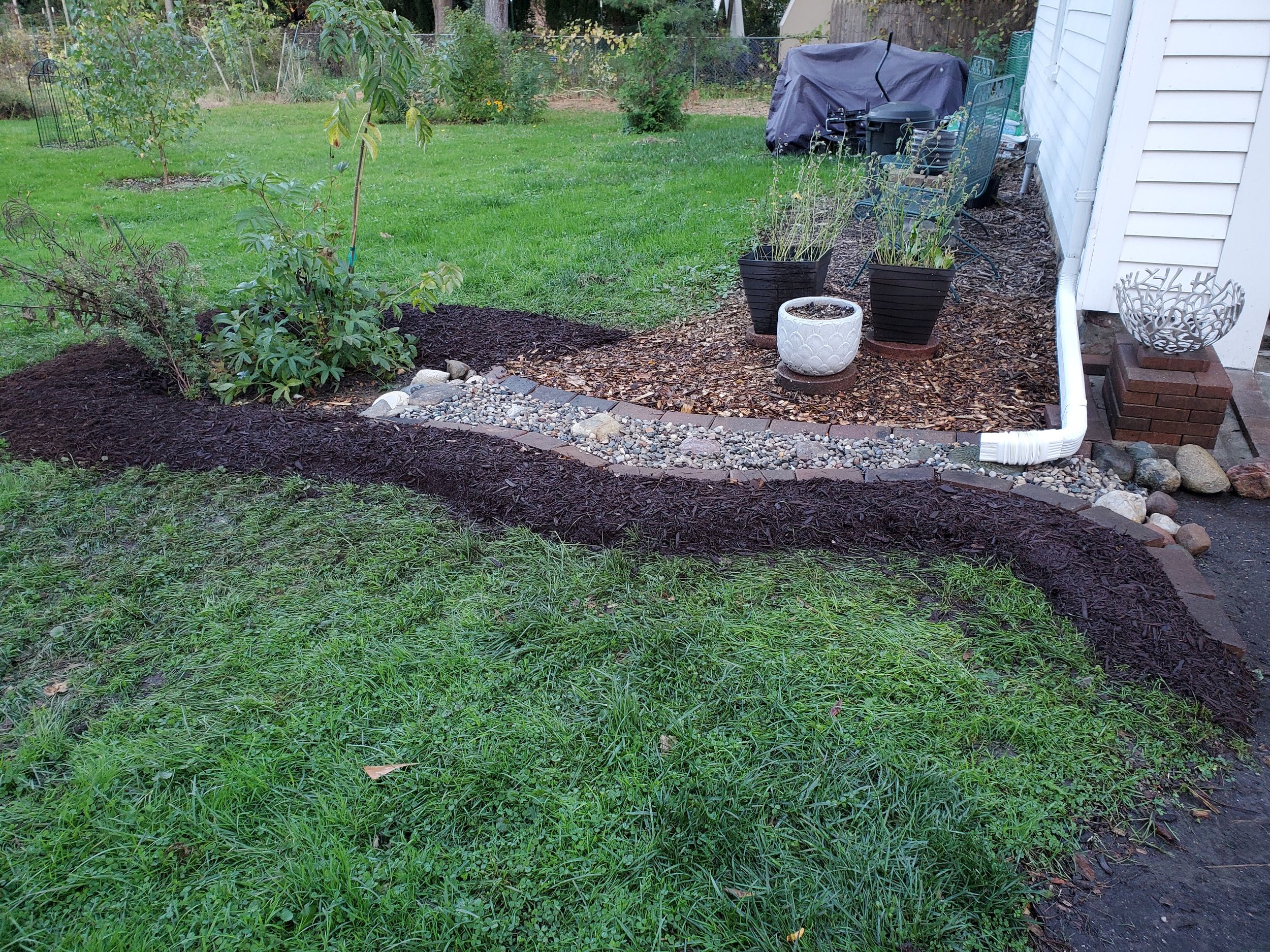
Planting
Timing of planting is important. Planting should be done in the spring through about July 4th. Generally speaking, summers which tend to be hotter and drier, should be avoided. Garden installation can resume in the fall when temps moderate and rain is more likely. Many will argue, me included, that fall is best, as new plants do not have to struggle through a harsh summer. Trees and shrubs can be planted starting early spring and again in the fall even through November. In spaces where new plantings cannot be easily and regularly watered, fall planting is by far the best option, but I would encourage those responsible to figure out some method of watering in the event that watering becomes needed more regularly.
Planting is the least labor intensive part of the work. I recommend shovels, trowels and plant augers- used to plant plugs most attachments can be used with 3/8 sized battery operated drills. Some auger bits are longer which can help limit how often you are up and down. Using an auger is a game changer for sure, as even hard ground can be easily planted and auger planting minimizes soil disturbance which is very important to limit weed regrowth. I am a strong proponent of smaller stock size except when larger trees are merited. Smaller stock is easier to plant, less expensive and will grow quickly especially if properly protected and managed. In less managed locations with high wildlife pressures (deer) larger stock is often recommended as they will hold up better.
Ideally you want plants to be at the soil line of the container whereas trees need their trunk flares above the soil. You are safe planting nursery grown trees and shrubs at the soil line established from the container, as reputable nurseries rarely pot things incorrectly . The biggest mistake made when planting trees and shrubs is planting too deep! Trees and shrubs should be put in the ground first followed by the forbs. Plant inside to out, so that you are minimizing how often you need to walk through newly planted areas. I like to plant completely one section at a time, and I do try to work in the shade later in the afternoon when possible.
Something that can be over-looked is where to stage plants. Do not leave live material in hot sunny locations, as they dry out quickly and can get very stressed. Place them in shady areas and keep them moist. I like to really water plants in their nursery pots prior to planting, so they get a better start when put in the ground.
Mulch was discussed in the preparation section, but one more mention is needed. It is very important to keep mulch away from the base of new plants as this can damage stems and trunks. Do not forget that in the fall, you will be gifted with the best mulch of all-Leaves. Fall leaves contribute organic mater to the soil, retains moisture, and creates habitat and protection for a wide range of beneficial insects and wildlife. As your garden fills out, especially if you have incorporated ground covers into your design, the need for supplemental mulch will greatly decrease. Ideally as the garden matures, mulch should only be needed in things such as pathways or stepping stone entryways- places made for walking to be clear of vegetation. As a garden fills out, if planted well, the plants and fall leaves themselves will fill the roll played at the start by the mulch.
Soil amendments are not needed. Creating native landscapes is different than a production vegetable garden which does require amendments. You want the landscape to thrive in the native soil, as any additives will not last. If species only thrive when soil is amended, then the wrong plants were selected for the site.
It is highly encouraged that species be planted in multiples whenever possible. This increases rates of survival. In any installation, a certain percentage of plants will not make it for any number of reasons. The goal is that enough of each species will survive to the point of being self-sustaining. Planting only one of each species, for example, sets up a situation for failure. Planting in multiples is in effect setting up redundant systems. Native species are essentially food that drive an ecosystem. Our goal is to make sure the demand does not out-strip the supply. It is for this very reason that Plants for Ecology encourages plants be bought in bundles whenever possible. This is especially true when planting plugs which are very cost effective but more delicate than larger potted plants.
Use fencing and repellants during the establishment phase of the landscape to protect vulnerable species. Herbivores can cause a lot of destruction in a newly planted habitat. Thinking long term, I recommend excluding whenever possible such visitors until the landscape can safely rebound from hungry wildlife. This does add cost to the endeavor and affects aesthetics, but without this protection, there is a high likelihood of loss. They can eat your neighbors Hasta until the landscape becomes robust enough to handle wildlife pressures.
Planting via direct seeding of the land is an option. This can be a very inexpensive method to utilize, but it is much less precise and germination in never that consistent. Bare soil is required and erosion blankets are required to keep seeds in place. Seeding is best done in late fall or small areas can be seeded in winter utilizing the snow to show where seeds have be broadcast. Seeding is used in very large restoration projects in which the cost of plants would bust the budget. Seeded areas are cut 2-3 times the first year once seeds have germinated. This is done to eliminate annual weeds that will compete with the native seedlings. From the 2nd year forward, weeding and other invasive species removal is the most important requirement. Seedings can be water to help things along, but in large natural areas, watering is many times not an option. Established plantings will on their own spread and rejuvenate by self seeding. I always spread extra seed into existing beads taking care to spread only the seeds of plants that need larger populations.
Formal versus “Wild” and how to design your landscape
Very old White Oak living happily in the "D". Also shows a neighborhood with very traditional landscaping.
When designing a landscape, one can choose a very formal design to a very informal arrangement (and anywhere in between). All require work, but I do believe that very formal designs are more labor intensive. I tend to use a combination. For example, I will have very defined bed lines but the beds themselves will be planted is if the flora were dispersed at nature’s providence. The size of the property matters greatly. Those with large properties will need to approach things differently than those in smaller denser communities. For example, a large shade tree may not impact the sun/shade ratio of a large property much but it will impact greatly one whose yard is small. Even so, large or small, a majestic tree like an Oak can be a wonderful anchor to one’s property and a mecca for wildlife.
Municipalities all have codes and rules that govern how property must be maintained. Generally, your property must be well maintained, and you should act like a good neighbor. A well maintained landscape is the best advertisement for native plants. There is no such thing as a maintenance free landscape. Make design cues well-recognized. Do not create obstacles to maintenance. Show observers that you used design principles for your native habitat. I strongly believe that the garden must fit the space. If you are unsure how to achieve this, reach out for help in your design.
Results depend on effort and luck!
1. Water: It is very important to diligently water a new planting. You want the area to be moist, not wet- rain gardens or areas that naturally remain wet or hold extra moisture are the exception. Water in the morning or the evening. If you cannot do either, water when you can. Some areas of a planting can be drier than others. Test the different areas by digging down a bit to test the moisture of the soil- water accordingly. Pay close attention to plantings under trees, as these areas can be drier than others.
2. Weed: keep up on weeding and remove them as soon as possible. Prioritize more aggressive weeds like Quack Grass, Thistle, Bindweed, Dandelions… It is easier on new plantings to utilize an herbicide to tackle stubborn weeds. Weeds create completion and make it more difficult for natives to establish. If you have turf grass butting up to the new bed, keep it mowed and blow clippings away from the bed. Lawns harbor many weedy species, but regular mowing does keep them at bay. Weeding will be an on-going need, but it does become easier as a planting becomes more dense.
3. Growth Expectations: It can take up to 3 years for a bed to establish and fill out. The first year may look sparse as plants focus on establishing their roots and getting through the first season. Some plants will not make it for various reasons within or beyond your control. Don’t sweat it, just do your best. The second year you will see some top growth and expansion, and this will be a good time to assess which ones are doing well and which ones are struggling. Take this time to make some adjustments. Watering needs will be much less the second year except for any new additions which will need regular watering. The third year is when you will typically see a real expansion and growth. Watering needs will be minimal to almost not needed. Exceptions are if there is extended drought.
4. Clean-up and pruning are not a big factor. Pruning need only be done on dead limbs or when trees or shrubs possibly expand to places that cause problems. Young trees and shrubs should otherwise be left to grow. Leaf litter should be left in the beds to build the soil, retain moisture, and prevent weeds- it is a natural process. In urban and suburban environments, leaves can blow and pile up in some areas while other areas look bare. If leaves seem a bit too thick in certain areas, they can be moved around and added to areas that have little coverage. Do not cut back plants in the fall. If a tidier look is wanted, wait until mid-May to cut things back. Many beneficial creatures utilize spent stems as safe harbor in the winter. These creatures in turn are a major food source for birds in the spring. By mid-May, most if not all insects have emerged and no longer require the old stems
5. Gardens are dynamic and will change. This is natural and what keeps things interesting. Make sure to take the time and just observe what is happening around the garden. Do not be too hasty, as maintenance work can wait until a solid plan is developed based on said observations.
6. Wildlife. Native plantings attract a host of wildlife from insects, amphibians, birds and mammals. Some animals feed destructively on plants, specifically deer, rabbits and groundhogs, and plantings are most vulnerable within the 1st three years. Apart from caging the whole planting or the most vulnerable species, efforts can be made to plant things known to be resistant to these creatures, but even such species can be susceptible and planting only resistant species impacts diversity and selection. Typically when planting densely, enough survive to keep the planting intact. Also remember that these animals are known to eat many other species that are not native as well, so many plant species are vulnerable not just natives. The three year window for establishment is definitely impacted by wildlife. Repellants can be used with varying success. Vulnerable species of trees and shrubs can be caged with great success, but this does add cost and affects aesthetics. Once established, many species can hold up to animal browsing but damage will still be noticeable at times.
7. Public Plantings: These tend to be the hardest to maintain. They usually rely on volunteer labor which can be hit or miss and are not as closely watched as a home landscapes. Wildlife may have easier access to public plantings and vandalism can be a problem too. Public spaces may also lack access to power and water which can present issues for maintenance and upkeep. If deciding upon a public planting, I would strongly consider having a well-conceived maintenance plan.
Other Important Considerations
The hallow area in Cup Plant where the leaves attach to the stem form a "cup" that holds water for thirsty visitors!
Water is an essential part of any habitat. All living creatures require water to sustain life. A reliable source of water will encourage creatures to visit and even take up residence in your square of living green. Water features can be as simple as a birdbath to as complicated as a pond and stream. Cup Plant, or Silphium perfoliatum, is very interesting indeed. It received its common name as a result of how its leaves attach to the stem, as it forms a reservoir that captures and retains water. This water is then utilized by a wide variety of wild visitors. A living water feature!
A rain garden is a special type of water feature that is designed to capture rain water and prevent run-off and associated pollution from entering water systems. In simple terms, rain gardens are sunken garden beds in which water is collected on a temporary basis.
Thew water is utilized by the plants or becomes ground water as it percolates down to the water table. A very common method of directing water to the bed is by redirecting the downspouts on one’s home so that water flows into the rain garden. Although water does not pool, rain gardens are very moist, so plants that love their roots to be very moist are ideal for such a garden feature. Eupatorium perfoliatum, or Boneset, is an ideal plant for a rain garden. Plants for Ecology has a list of plants that will do great in a rain garden.
If you are a property owner who has naturally occurring water features such as wetlands, ponds, steams/rivers, or lakes, then you are in a very special and wonderful situation, as this gives you a great opportunity to create an incredible natural habitat that will support a great amount of wildlife. The creation of buffer zones or riparian borders is the best way to protect water quality and create dynamic habitats. These habitats filter extra nutrients and pollutants before they reach the water, and they also stabilize the banks and protect against erosion. Property owners who have these special features on their landscape have a responsibility to act wisely and protect them. There are also state and municipal regulations that govern and protect these waterways and features. For those wishing to plant along the water’s edge, it is very important to understand the ecology of the area, so it would be wise to consult with those who are experts in natural area management and restoration.
Signs are helpful. There are many signs on the market that indicate that your landscape is a native habitat, and you can always create your own. These signs are used to inform those passing by or neighbors that there is intention behind your efforts. Let’s face it: even with all your cues to care, a native landscape is still different from the foundation and turf grass plantings that dominate our spaces. You are rocking the boat, but sometimes a bit of information will allay fears. Yes, whenever you move contrary to prevailing trends, people will get anxious.
I am not a big proponent of bird feeders. These create artificial sources of food for wildlife who then tend to then live above their means. If you want birds in and around your landscape, it is best to plant what will bring them to you. Do your research on plant species to include in your planting that attract birds. The more diverse your planting the better.
I am a huge proponent of vegetable gardens. Ecologically, humans are part of the equation- we matter and so does how and where we source our food. Now most of us will not be able to provide all the food we need through our own gardens, but even doing some is important. Even small gardens can be very productive if done properly. One should also recognize that many native species are also edible. We have to utilize everything we can in order to solve the problems we face. Our industrial food system is broken, and we need to figure out how to replace it.



